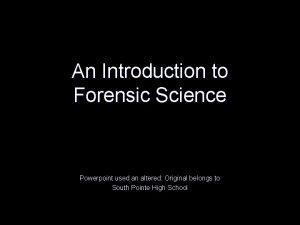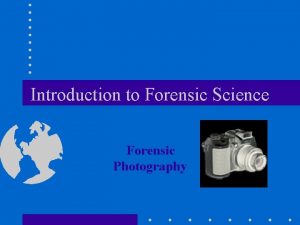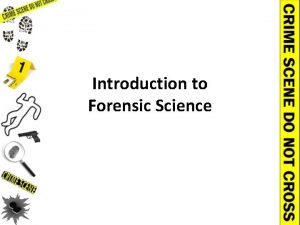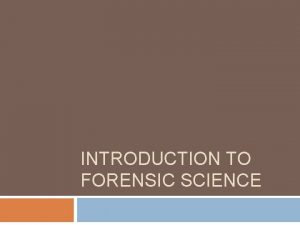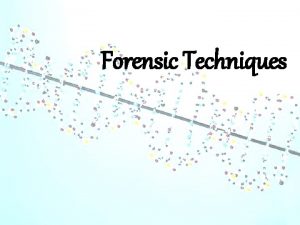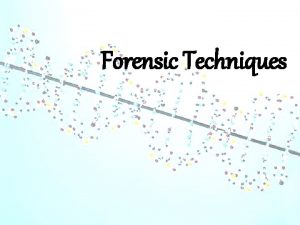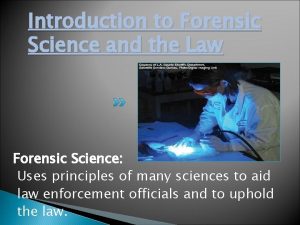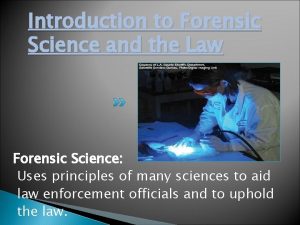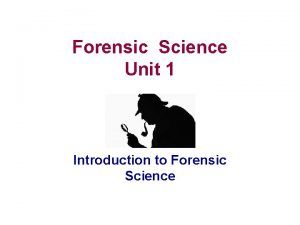Introduction to Forensic Science to the Law Forensic













- Slides: 13

Introduction to Forensic Science & to the Law

Forensic Science l l l It is the study and application of science to matters of law (criminal and civil) Includes the business of providing timely, accurate, and thorough information to all levels of decision makers in our criminal justice system Also called criminalistics

Criminalists vs Criminologists l l A criminalist examines physical evidence for legal purposes Criminologists study the crime scene for motive, traits, and behavior as to help interpret the evidence – They learn to think like criminals

Forensic Scientists l l Applies the principles and techniques of the physical and natural sciences to the analysis of the many types of evidence that may be recovered during a criminal investigation May also provide expert court testimony – Known as an expert witness l Individual whom the court determines possesses knowledge relevant to the trial

Developments in Forensic Science l l l 700 s AD- Chinese used fingerprints to establish identity of documents and clay sculptures ~1000 - Roman courts determined that bloody palm prints were used to frame a man in his brother’s murder 1149 - King Richard of England introduced the idea of the coroner to investigate questionable death 1200 s- A murder in China is solved when flies were attracted to invisible blood residue on a sword of a man in the community 1598 - Fidelus was first to practice forensic medicine in Italy

Developments in Forensic Science l l l 1670 - Anton van Leeuwenhoek constructed the first high powered microscope 1776 - Paul Revere identified the body of General Joseph Warren based on the false teeth he had made for him 1784 - John Toms convicted of murder on basis of torn edge of wad of paper in pistol matching a piece of paper in his pocket 1859 - Gustav Kirchoff and Robert Bunsen developed the science of spectroscopy 1864 - Crime scene photography developed

Matthew Orfila (1787 -1853) l l Father of forensic toxicology 1814 published first scientific treatise on the detection of poisons and their effects on animals

Alphonse Bertillon (1853 -1914) l l Devised first scientific system of personal identification Developed anthropometry - systematic procedure of taking a series of body measurements as a means to distinguish one individual from another

Developments in Forensic Science l l l 1879 - Alphonse Bertillion developed a system to identify people using particular body measurements 1896 - Edward Henry developed the first classification system for fingerprint identification 1900 - Karl Landsteiner identified human blood groups 1904 - Edmond Locard formulated his famous principle, “Every contact leaves a trace” 1922 - Francis Aston developed the mass spectrometer

The Locard Exchange. Principle 1. You are sitting at your desk. What are you in contact with? What possible transfer of material could have taken place? How could you have prevented any transfer if you had thought about it first? What transferred material could be traced back to you directly? 2. Think about when you came to school today. Did you leave any evidence that you were here other than being observed by others (eye witnesses)? 3. Is it difficult not to leave a trace? And, after the fact, is there lots to worry about from leaving evidence of your presence? 4. Do you think premeditated contact can diminish identifiable transfers? Give some examples of where destroying evidence could leave more that could identify you.

Sir Francis Galton (1822 -1911) l l Studied and developed methodology for classifying fingerprints “nature vs nurture”

Developments in Forensic Science l l l 1959 - James Watson and Francis Crick discover the DNA double helix 1977 - AFIS developed by FBI, fully automated in 1996 1984 - Jeffrey’s developed and used the first DNA tests to be applied to a criminal case

People of Historical Significance l l l Leone Lattes- developed a procedure to determine blood type from dried bloodstains Calvin Goddard- used a comparison microscope to determine if a particular gun fired a bullet Albert Osborn- developed the fundamental principles of document examination Walter Mc. Crone- utilized microscopy to examine evidence Hans Gross- wrote treatise on criminal investigation
 Chapter 1 intro to forensic science
Chapter 1 intro to forensic science Forensic science powerpoint
Forensic science powerpoint Forensic science unit 1 review
Forensic science unit 1 review Forensic science an introduction
Forensic science an introduction My favorite subject is arabic
My favorite subject is arabic Forensic anthropologist vs forensic pathologist
Forensic anthropologist vs forensic pathologist Forensic psychiatry vs forensic psychology
Forensic psychiatry vs forensic psychology Sciencefusion think central
Sciencefusion think central Newton's first law and second law and third law
Newton's first law and second law and third law Si unit of newton's first law
Si unit of newton's first law V=k/p
V=k/p Charles law constant
Charles law constant Hegar's sign
Hegar's sign Morphology definition forensics
Morphology definition forensics

